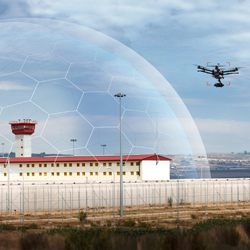 |
|
|
Williams Meredith recently stepped out of his Kentucky home to see a drone hovering over his porch, videotaping his young daughters by the family pool. It wasn’t the first time one of these small flying devices had wandered over to take a look, but it had never gotten so close. So he did what any red-blooded American would do when confronted with a home invader – he blew it from the sky with a single shotgun blast.
The confrontation is another example of the rising use of unmanned aerial vehicles (UAVs), and a confirmation that neither laws or law enforcement have kept up. In recent months, drones have been used to smuggle drugs behind prison walls and enable paparazzi to crash celebrity weddings. Officials at power plants and other secure facilities report seeing these vehicles buzzing their perimeters, sparking concern they could be used by criminals or terrorists.
Tracking drones
Those fears have opened up a new market for drone detection systems like those marketed by Dedrone, whose Drone Tracker device has been installed by a variety of companies with property to protect. Williams Meredith decided to get one to protect his home.
“This has happened before, and when the police come there is no evidence there was even a drone here – let alone where it was over my property,” he explains. “Now we have the capacity of being alerted when it gets here no matter where it is. We now have video and sound of it being here.”
Dealing with drones has been |
For Meredith, the issue is protecting home and family and providing evidence to law enforcement. After shooting down the drone it was he (not the drone’s owner) who was arrested and charged with first degree criminal mischief and wanton endangerment for discharging a firearm.
Drones are so new that privacy and property protection laws haven’t caught up. The Federal Aviation Administration – after prodding by Congress – has recently begun to rewrite regulations and in preparation to issue permits for the commercial use of UAVs.
“They finally published [regulations] for comment at the beginning of this year, and they’ll be lucky if they get them passed and promulgated by some time in 2016,” says John Fry, a partner in the new drone practice group at Morris, Manning & Martin, LLP.
Meredith expects the charges against him to be dropped, and some experts agree that’s likely even in the absence of new laws. University of Miami law professor Michael Froomkin says it’s reasonable for a homeowner to assume that “robotic intrusions” are menacing and that you may have the right to “employ violent self-help.” That’s also the way Meredith looks at it.
Growing market for drone trackers
“There are very few products on the market today that are really addressing the security concerns with drones,” says Dedrone CEO Brian Edmunds. “Ours differs quite a bit from some of the others in that we have a multi-sensor approach to drone detection.”
It’s equipped with microphones for audio recording, video cameras and near-infrared sensors for image detection in low light. Using multiple parameters such as noise, shape, and movement patterns, it can detect all types of drones including silent gliders. The built-in camera saves images and videos in HD quality, providing the type of evidence of the threat intrusion that Meredith lacked in his drone encounter.
“Detection is really a big task because there are so many things flying in any area,” says Edmunds. “You have planes, helicopters, birds, leaves, and you have to be able to differentiate between the things that are safe and the drone that may be flying in your airspace.”
Critical infrastructure such as gas |
The system is programmed to distinguish these objects based on sound and unique flight patterns. Once confirmed, the system automatically sends a text or email alert to a smartphone or other device. It also starts recording video that is stored locally for later use.
As drones have multiplied, some have garnered headlines. Early this year, when a drunken intelligence agency employee crashed his drone on the White House lawn, inquiries coming into Dedrone ratcheted up as well.
“Right now we’ve been talking with prison facilities, private industry and individuals as well,” says Edmunds. “People are starting to see more and more that this is a threat and they want (Drone Tracker) for their own personal security.”
Critical infrastructure such as gas and electric generation companies and nuclear power plants are also deploying the system to guard their facilities against a threat that often goes undetected, he adds.
Lagging laws for UAVs
Dealing with drones has been complicated by laws and regulations that never considered the idea of small, relatively cheap unmanned remote controlled vehicles. The FAA has been writing drone regulations, but only for commercial use.
The FAA is issuing licenses – called 333 Exemptions – to companies such as Amazon.com, which wants to use the vehicles to deliver packages to customers. The agency has issued almost 2,000 of the exemptions so far this year.
“That’s a pretty dramatic increase in the allowance rate, but we still have one of the most significant aspects of drone operation, which is the airspace management and safety, still being managed by exemption,” observes Fry.
In the meantime, states are beginning to debate and pass legislation to protect privacy and property rights, according to Tony Roehl, another partner in the Morris, Manning & Martin, LLP drone group.
“We found that the U.S. is behind other countries that have addressed drones much more comprehensively at the national government level,” he explains. “That’s why you’re seeing a lot of innovation in drones coming from outside the United States.”
Meanwhile, business and individuals are taking matters into their own hands, deploying detection systems and even confronting drones head on.











































